Go To Your Bed and Stay There
By Michele Welton, Dog Trainer, Breed Selection Consultant, Author of 15 Dog Books
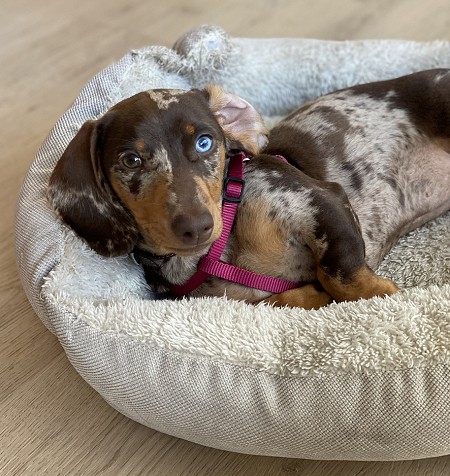
Smooth Miniature Dachshund, red merle color, resting comfortably on her bed.
The command "Go to your bed" or "Go bed" is one of the most powerful commands to teach your dog. When told, he should go straight to his designated dog bed or blanket and stay there.
For this exercise, your pup should be at least 10 or 12 weeks old and should behave decently on a leash.
You might wonder if Go bed could refer to his crate. It could. But when I want my dog to go into his crate, I usually use "Go crate."
I use "Go bed" or "Go to your bed" to refer to an open dog bed placed somewhere in the room.
You can even move his bed from room to room. For example, if you're watching TV in the living room, you might put his bed there so he can hang out with you. When you head for your den to work on your computer, you could carry his bed to the den.
Or you can have different beds in different rooms. No, that won't confuse him. When you say, "Go bed", simply point/gesture at the bed you want him to use.
Three reasons why "Go bed" is one of the most powerful commands to teach your pup
- Go bed is calming. When your dog must hang out on his bed and not walk away from it, he learns patience and impulse control, two qualities that are essential for every dog (but especially young, energetic, or excitable dogs) to learn. Go bed becomes almost a meditative experience as the pup learns to relax his body and calm his mind even when the world keeps churning around him. He learns to ignore kids playing, the phone ringing, the vacuum cleaner, the mailman.
In addition, dogs with anxieties and noise sensitivities dramatically improve when they're required to control themselves on their bed. It doesn't happen immediately. But in a comparatively short time, you'll see the difference.
- Go bed is practical. Instead of letting a young or mischievous dog loose in the house, free to practice bad habits, you can let him hang out with you in a safe space – his bed. Sure, you could put him in a crate or pen, but if he knows how to relax on his comfortable bed, he can stay right out in the open with you, wherever you are.
- Go bed shows your pup that you're in control. He learns that sometimes he needs to do something simply because you, his trusted leader, says so. He must stay there quietly, just watching the world go by, because you want him to.
Good beds to use
 For most pups, the best kind of bed for teaching this command is an elevated bed. Either a hammock-style bed, like this one by K&H Products....
For most pups, the best kind of bed for teaching this command is an elevated bed. Either a hammock-style bed, like this one by K&H Products....
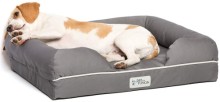 ....or a raised bed like this Petfusion® memory foam. I like an elevated bed because it's so obvious when the dog is ON it, and when he's not.
....or a raised bed like this Petfusion® memory foam. I like an elevated bed because it's so obvious when the dog is ON it, and when he's not.
 Or you can use a non-elevated bed with bolsters around the edge to help define the bed. Very small dogs often prefer a non-elevated bed because they don't need to hop up onto it. (The downside is that it's more tempting to edge himself off the bed onto the floor!)
Or you can use a non-elevated bed with bolsters around the edge to help define the bed. Very small dogs often prefer a non-elevated bed because they don't need to hop up onto it. (The downside is that it's more tempting to edge himself off the bed onto the floor!)
"Go bed" is one of the easiest commands to teach.
Position the bed in the middle of a room (rather than in a corner or against a wall) so you and your pup can easily walk around it. Or practice in your yard where there's lots of space to walk around the bed.
When you start the training, your pup should be on leash. As you approach the bed together, say, "Go bed" in a cheerful voice.
Point/gesture toward the bed and use the leash to gently steer your pup onto the bed. The moment all four feet are on the bed, say, "Yes!" or "Good!" and give him a treat while he's on the bed. Then say "Okay" and walk away with him. Repeat many times.
Your pup won't get on the bed?
This is uncommon with a curious young pup, but might occur with some older dogs who balk at unfamiliar things.
First, try persisting with leash pressure; sometimes a few moments of firmness will break through the pup's initial resistance.
But if that doesn't work and the pup continues to fight mightily against getting on the bed, break the exercise into smaller, easier-to-master bits.
- Spend some time just walking him over to the bed and dropping a treat on it. If he reaches onto the bed to eat it, say "Yes!" or "Good!" Then walk away, turn around, and come back for another pass.
- Eventually try to maneuver him so that the bed is between the two of you. Put a little pressure on the leash to encourage him to walk across the bed to your side. If he puts even one foot onto the bed, say "Yes!" or "Good!" and give him a treat.
- After several successes with one foot, withhold your praise/treat until he puts both front feet on the bed, and so on.
What should your pup DO when he's on the bed?
At first, he doesn't need to do anything. Simply walk him on, praise/treat, say "Okay", and walk him off.
When you think he's ready to stay longer, say "Yes" or "Good" when he gets on the bed and give him the treat. But instead of saying "Okay" and walking away with him, just stand there close to him.
 If he tries to step off the bed, use the leash to gently stop him. Then loosen the leash again. Check him gently with the leash, then loosen it, as many times as necessary until he shows understanding that he's supposed to stay there.
If he tries to step off the bed, use the leash to gently stop him. Then loosen the leash again. Check him gently with the leash, then loosen it, as many times as necessary until he shows understanding that he's supposed to stay there.
When you're first teaching this exercise, have your dog stay on the bed for just a few seconds. Then say, "Okay" and walk him off. He must wait for your "Okay" before stepping off.
Now it's simply a matter of gradually increasing the time he needs to stay on the bed before you give him the release word.
Your pup doesn't need to lie down on the bed. Of course he can if he chooses to, but he can also sit or stand or move around. He simply can't get off. No barking either!
Next step: you circle around the bed while your pup stays on it.
Some pups will try to step off the bed when you move. So the first few times you try it, raise the leash vertically above your pup's head with a bit of gentle(!) tension to remind him to stay on.
 I like to place my left hand, palm UP, above the dog's head, then drape the leash across my fingers. If he tries to step off, I can quickly raise my left hand to check him with the leash.
I like to place my left hand, palm UP, above the dog's head, then drape the leash across my fingers. If he tries to step off, I can quickly raise my left hand to check him with the leash.
Stay close beside the bed as you circle it. It's fine if your pup moves around on the bed as you move around the bed. But he should not step off until you say "Okay."
Patience and persistence are the keys here. If YOU don't give up, your pup will eventually sigh and stay on the bed. And as far as leadership goes, you will have just taken a giant step forward in his eyes!
Add distractions.
Once your pup will reliably stay on the bed for up to a minute, add distractions to make his understanding even more solid:
- Hum or sing or whistle.
- Do a few knee bends or jumping jacks.
- Have one of your kids trot through the room, bouncing a ball.
Remember: your pup doesn't need to lie down on the bed. He can if he chooses to, but he can also sit or stand or move around. He simply can't get off the bed. No barking either.
Don't TEASE the dog. Don't pat your thighs to encourage him to come to you. Don't speak to him or stare at him.
You're not trying to make him fail. You're trying to build up his confidence that he CAN stay on the bed.
As he gets more reliable, you can progress to sitting in a chair and reading a book. But keep an eye on him. You don't want him wandering around the room while you're engrossed in your book!
Eventually you'll be able to leave the room and return to find him still on his bed. What a marvelous exercise in self-control!
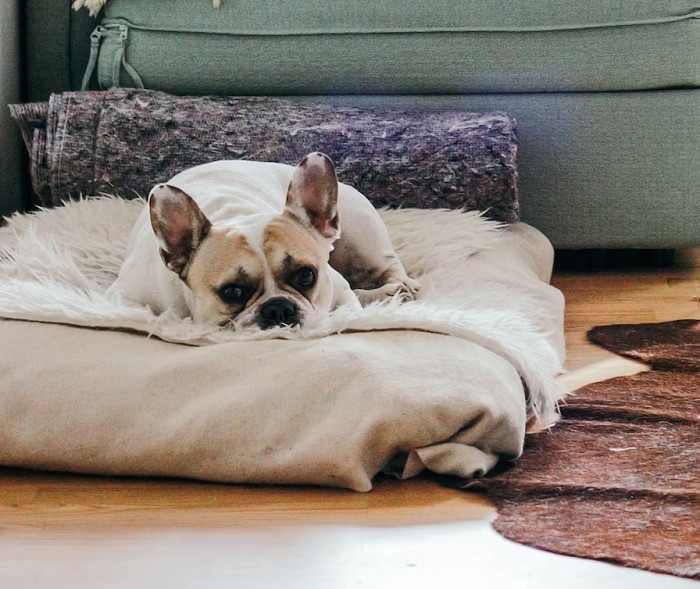
How long can your dog stay on his bed?
I don't start teaching Go bed until a pup is 10 or 12 weeks old, and then I only have him stay on his bed for a minute or two. I increase to 15-30 minutes for pups 3 to 6 months old. Pups over 6 months can stay on their bed for an hour.
 If you're laughing out loud at the idea that your rambunctious dog could hang around on his bed for an hour.... then he is the perfect candidate for learning how.
If you're laughing out loud at the idea that your rambunctious dog could hang around on his bed for an hour.... then he is the perfect candidate for learning how.
Because any pup who feels secure and stress-free is perfectly able to relax for an hour or two on a comfy bed in a comfy house with his trusted leader close by. If your dog "can't", that's powerful evidence that he is feeling anxious/restless, rather than secure and stress-free.
When you teach him how to relax and be calm, his stress levels will go way down and his contentment levels will go way up. Go bed is the perfect lesson to make that happen.
 In fact, it's often easier for a dog to stay on his bed for an hour than to stay for just a few minutes.
In fact, it's often easier for a dog to stay on his bed for an hour than to stay for just a few minutes.
You see, if he learns that he only needs to wait 20 seconds and then you'll let him up, he'll be tense the whole time. He'll stare at you, shift restlessly, and tighten his muscles whenever you look in his direction. He's waiting for the slightest sign that he can explode off his bed and be free, free, free!
Not very calming or meditative, is it?
 However, over an hour, most pups relax and go to sleep.
However, over an hour, most pups relax and go to sleep.
But let's say your pup doesn't go to sleep, at least not right away.
What if he stares at you?
Don't make eye contact. Most dogs interpret eye contact with you as an invitation to interact. In fact, your pup may try hard to make eye contact with you so he can assume his most charming/pathetic expression that will persuade you to stop this nonsense and play with him instead. Just ignore it.
What if he inches farther and farther off the bed?
This is a judgement call on your part.
He might start by hanging his front paws off the edge. You can almost see the thought bubble above his head: "There," he says reassuringly, "that didn't hurt anything, did it? After all, most of me is still on the bed!"
Then he's stretching one paw until it touches the floor. "Ooh, it feels good to stretch. How about another inch? How about two inches..."
You can see where this is headed, right? This is why I prefer elevated beds for teaching Go bed, because it's easier to see when the dog has come so far off the bed that he's touching the floor. With other beds, it's more of a judgment call as to when he is on versus off.
In any case, when he truly seems off to you, use the leash to scoot him back on. And be sure not to give him any treats as you do! You don't want him to learn this pattern: leave bed → get put back on bed → get a treat! Dogs will quickly learn the worst patterns.
What if he tries to chew on the bed (or the leash)? What if he whines or barks?
"No. AH-ah." Follow up with a corrective technique that works for your particular pup.
What if he rolls onto his back with all four feet in the air?
 Ha-ha! That's fine. All he has to do is stay on the bed, quietly and peacefully. That looks pretty quiet/peaceful to me!
Ha-ha! That's fine. All he has to do is stay on the bed, quietly and peacefully. That looks pretty quiet/peaceful to me!
Remember: your pup doesn't need to lie down on the bed. He can if he wants to, but he can also sit or stand or move around. He simply can't get off the bed. No barking either.
Releasing your dog from his bed
Only use Go bed when you're sure you will remember to keep a close eye on your pup. If you get called away for anything important, first release your pup with "Okay" and get him off the bed before you go answer it.
Otherwise, when he's first learning this exercise, he'll probably walk off the bed while you're busy elsewhere. That's not good for your leader-follower relationship. Once you've begun the "Go bed" exercise, he needs to wait for YOU to release him.
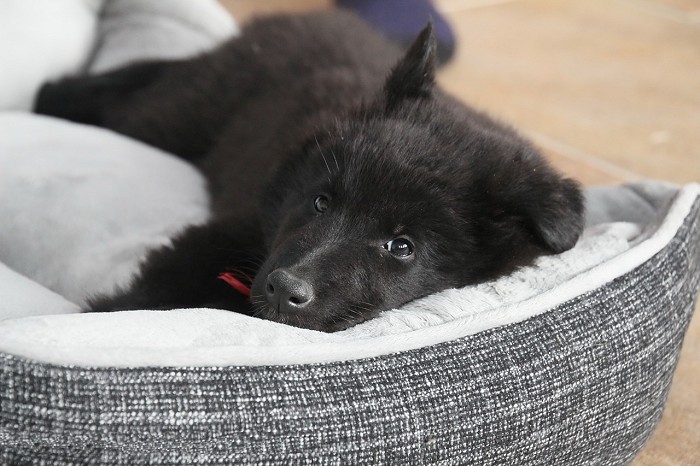
Using "Go bed" to sound-proof your pup
Once a dog shows that he fully understands his responsibility to stay on the bed for an extended period of time, I add sound effects.
Every pup should be able to relax even when he hears fireworks, thunderstorms, other dogs barking, a baby crying, kids squealing and playing, a vacuum cleaner, construction equipment, traffic sounds, and emergency vehicle sirens.
Sadly, some pups are hyper-sensitive and hyper-reactive to harmless sounds. Some breeds tend to be more sound sensitive than others, so clearly there is a genetic component.
But more commonly, sound sensitivity is caused by owners who respond improperly when their dog acts worried or nervous. Typically, owners respond by trying to reassure the pup with soothing words and petting.
Unfortunately, that's the worst thing to do. A soothing voice and petting are interpreted by dogs as positive reinforcement of whatever behavior they're exhibiting at the time. If you reward nervous behavior, you're going to see more nervous behavior. Not less.
Owners who soothe and pet and cuddle a worried dog aren't helping the dog, but are (unintentionally) making things worse.
I recommend using Go bed to prevent sound sensitivity from developing in your dog. Or if you already have a pup with this problem, you can use Go bed to help the pup overcome it.
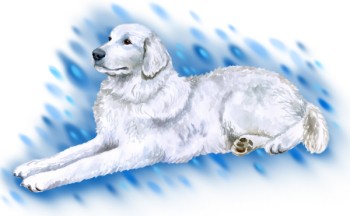 Get hold of a sound effects CD such as Calm Pet: Desensitizing Sounds or Sounds for Hounds. Or just find free sound effects on YouTube. Try to include all the sounds I mentioned earlier.
Get hold of a sound effects CD such as Calm Pet: Desensitizing Sounds or Sounds for Hounds. Or just find free sound effects on YouTube. Try to include all the sounds I mentioned earlier.
Play these sounds for 10-15 minutes a day while your puppy is on his bed. If the pup ignores the sounds, walk over a couple of times and give him a treat. This helps him associate hearing and ignoring sounds with rewards.
The first week the volume should be so low as to be barely audible. The following week, increase the volume a bit. Keep creeping it up, over time, until it's about the level the pup would hear in your neighborhood.
Teaching coping skills to fearful dogs
If your dog acts fearful (cowering or shaking) but stays on the bed, reduce the volume for a few days. Other than that, ignore the fearfulness. Don't speak to him, look at him, or give any treats while he's looking or acting fearful.
Whether fearful or not, if he gets off his bed, say, "No" or "AH-ah", give the leash a mild corrective tug, and lead him back on.
If he keeps getting off and running into another room, move the bed near a heavy piece of furniture to which you can attach the leash. Make it very short so he can't get far off the bed. Of course you will be right there in the room with him and can quickly usher him back onto his bed.
What you're doing is removing his opportunities to practice poor coping skills – running, hiding, pacing, or coming to you for frantic cuddling. Allowing him to choose any of those options only makes the situation grow progressively worse.
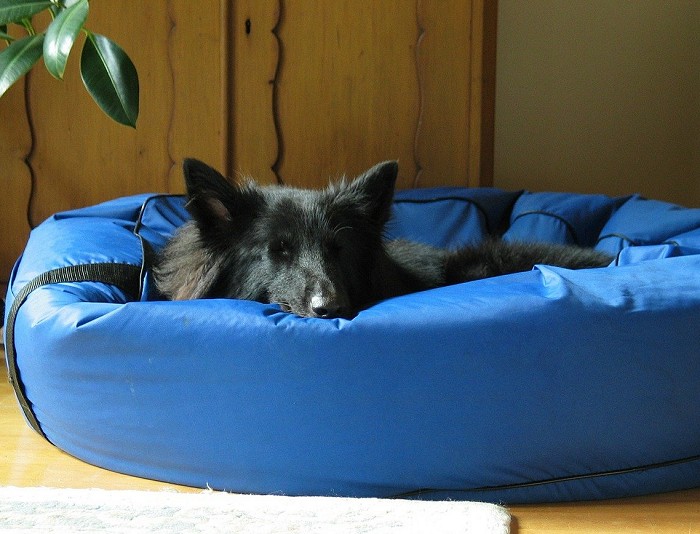
When you remove those bad options by requiring him to stay on the bed, he might still cower and shake for quite some time. But as he focuses more on his responsibility to stay on the bed and less on the sounds that are becoming more familiar and are apparently harmless, he will work through his nervousness and develop much better coping skills.
Yes, we're stressing the pup. But imagine the stress he would experience throughout his life whenever something frightened him and he had no coping skills other than running away or barking... or biting.
We don't help our dogs by avoiding all stress in their lives. We help them by exposing them to stress in a safe, controlled environment and teaching them to cope calmly with it. Dogs with "issues" can't grow or change unless they're nudged out of their comfort zone. Working through something they didn't think they could do builds confidence and is satisfying and empowering to dogs. To us, too!
My best-selling books – now available FREE on my website
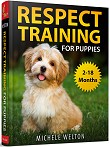 Respect Training For Puppies: 30 seconds to a calm, polite, well-behaved puppy is for puppies 2 to 18 months old. Your puppy will learn the 21 skills that all family dogs need to know. Click here to read for free.
Respect Training For Puppies: 30 seconds to a calm, polite, well-behaved puppy is for puppies 2 to 18 months old. Your puppy will learn the 21 skills that all family dogs need to know. Click here to read for free. Teach Your Dog 100 English Words is a unique Vocabulary and Respect Training Program that will teach your adult dog to listen to you and do what you say. Click here to read for free.
Teach Your Dog 100 English Words is a unique Vocabulary and Respect Training Program that will teach your adult dog to listen to you and do what you say. Click here to read for free. 11 Things You Must Do Right To Keep Your Dog Healthy and Happy helps your dog live a longer, healthier life. Get my honest advice about all 11 Things before you bring home your new puppy, because some mistakes with early health care cannot be undone. Click here to read for free.
11 Things You Must Do Right To Keep Your Dog Healthy and Happy helps your dog live a longer, healthier life. Get my honest advice about all 11 Things before you bring home your new puppy, because some mistakes with early health care cannot be undone. Click here to read for free.
